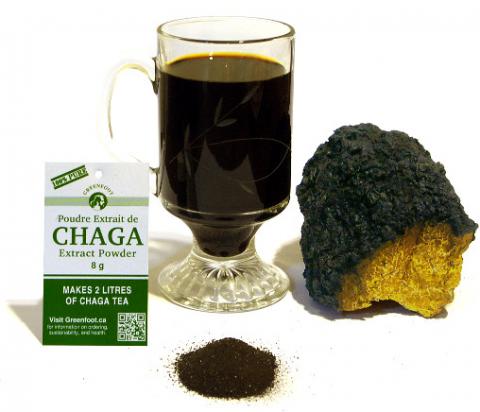 This is chaga as it was always meant to be. Just add 1/2 gram of extract to 250ml of hot water and you have a cup of chaga tea, instantly! The most amazing part of all is that the cost for a cup of chaga made from our extract is about the same as the cost of chaga prepared from loose chaga tea. More specifically, 1 gram of Greenfoot extract makes as much tea as 5 grams of dried ground chaga.
This is chaga as it was always meant to be. Just add 1/2 gram of extract to 250ml of hot water and you have a cup of chaga tea, instantly! The most amazing part of all is that the cost for a cup of chaga made from our extract is about the same as the cost of chaga prepared from loose chaga tea. More specifically, 1 gram of Greenfoot extract makes as much tea as 5 grams of dried ground chaga.
WHY IS OUR EXTRACT SO CHEAP?
The short answer is:
For sustainability! Ending the disparity between harvesters, distributors and consumers is the only way we can bring balance to the market and make chaga sustainable. Low cost extract was a happy side effect of that process. Enjoy.
The long answer:
Currently society sees it as the harvester’s responsibility to harvest sustainably and the distributor’s responsibility to deal with good harvesters. This doesn’t work in the case of chaga. (I’m not so sure it works very well in other cases either). The competition and greed that creeps into this type of system is causing chaga to be over-harvested and making it more expensive then it needs to be.
In order to ensure that chaga is managed sustainably it’s necessary to eliminate any motive to act competitively because this ultimately leads to over-harvesting. To do this we must start by being fair to the harvesters. Many harvesters in Canada earn $2/pound for their chaga. (It is common for distributors to force harvesters to compete against each other for lower prices.) This type of market doesn’t allow harvesters to create permanent employment and removes the incentive to manage chaga sustainably. Greenfoot ensures harvesters are paid fairly and empowers them to become competetive distributors by making chaga extract available to them at cost.
Ending the disparity between harvesters and distributors also ends the disparity between the consumer and the distributor. For example, harvesters must sell chaga to their community for a fair price in order to reduce the impact of recreational harvesters seeking chaga for personal use.
Offering chaga as an extract is more sustainable for other reasons too. By making chaga into an extract we can yield 50% more tea than the average consumer can when brewing their own chaga at home. It takes a lot of work to extract the nutrients from chaga and consumers just don’t have the proper equipment so a lot of good chaga gets wasted. That’s a shame considering it is such a scare resource.
We could try selling our extract for considerably higher prices to areas where chaga is not harvested but that’s hard to do and I’m not so sure that would be fair either. It’s better to let the market sort that part out for it’s self.

How long does it last out of the refrigerator if it’s brewed as a tea?
I did an experiment last year where I deliberately tried to ‘spoil’ chaga by innoculating it with rotten eggs and raw pork. I left the samples out for three months. Although I admit my microscope isn’t the best, I couldn’t see any signs of bacterial colonization. This is consistant with other reports that chaga is antibacterial. If you leave it out long enough, however, it can ferment or get moldy, but that happens really slow, if at all. And fermentation doesn’t actually make it poisonous, it just changes the flavour.
How long can it stay out of the fridge? That varies. I’ve had chaga sitting on my counter for months and it’s still fine. Other times I’ll notice it starting to ferment and developing off flavours as quickly as 3 days. You’re usually good for at least a week outside the fridge, though.